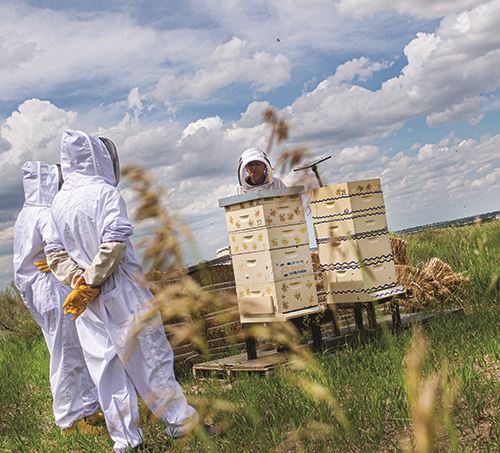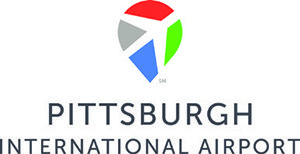Hosting managed bees on or near airport land can help bring awareness to the importance of pollinators and highlight an airport’s commitment to supporting local agriculture. On a very literal basis, airport beekeeping is a grass roots initiative that promotes healthy communities from the inside out.
When the topic of airport sustainability comes up, conversation usually centers on solar panels, electric ground support equipment, LED lighting and other energy-oriented innovations. But on-site bee programs are also beginning to generate a lot of buzz throughout the industry.
Creating pollinator habitat on or near airport land benefits native and managed bee species that help to pollinate food crops. In fact, the U.S. Department of Agriculture estimates that 80% of flowering crops require pollinators. That means they help create about one-third of all consumed food.
Hosting managed bees on or near airport land can help bring awareness to the importance of pollinators and highlight an airport’s commitment to supporting local agriculture. On a very literal basis, airport beekeeping is a grass roots initiative that promotes healthy communities from the inside out.
|
facts&figures
Location: Centennial Airport Program Scope: 4 hives, with approximately 200,000 total, on undeveloped airport land Safety Precautions: Hives are set on stands screwed into platforms that are tied down with ratchet straps to prevent foreign object debris on airfield Program Established: 2018 Lead Consultant: Vanasse Hangen Brustlin Inc. Master Beekeeper: Joe Komperda, Happy Busy Bees and Average Joe Guides.
Project: On-Site Apiary Location: Orlando Int’l Airport Program Scope: 200+ hives just outside perimeter fence, supported by native plants on airport land Established: 2012 Lead Consultant: Vanasse Hangen Brustlin Inc. Master Beekeeper: Jason Deeringer, Bee Serious
Project: On-Site Apiary Location: Pittsburgh Int’l Airport Program Scope: 10 apiaries with 150-175 colonies & millions of honeybees Established: 2012 Lead Consultant: Vanasse Hangen Brustlin Inc. Master Beekeeper: Stephen Rapasky, Meadow Sweet Apiaries Accolade: 2020 Governor’s Award for Environmental Excellence Key Benefits: Preventing & managing bee swarms proactively; productive use of undeveloped airport land; supporting long-term sustainability & land stewardship goals; opportunity for community engagement/education |
Positive Change Agents
Bee decline is a worldwide concern, addressed regularly by organizations such as the Food and Agriculture Organization, a specialized agency of the United Nations that focuses on international efforts to defeat hunger.
José Graziano da Silva, the organization’s director, summarizes the problem like this: “Bees are under great threat from the combined effects of climate change, intensive agriculture, pesticides use, biodiversity loss and pollution. The absence of bees and other pollinators would wipe out coffee, apples, almonds, tomatoes and cocoa, to name just a few of the crops that rely on pollination. Countries need to shift to more pollinator-friendly and sustainable food policies and systems.”
Select airports around the world are pitching in to help.
The first airport apiary was established more than 20 years ago at Hamburg Airport in Germany. The first U.S. airport to develop one was O’Hare International (ORD), in 2011. The initiative in Chicago is part environmental program and part community outreach. Located on a previously vacant, undeveloped grassy area on the east side of the airport, the bee program at ORD includes a job training partnership with the city’s Department of Family Support Services and the North Lawndale Employment Network.
By providing native plants on what might otherwise be considered “useless” real estate, ORD helps bolster the vulnerable bee population and also supports a local cottage industry. Certified naturally grown honey from the airport apiary is processed and sold under the Sweet Beginnings beelove™ product label. The local, all natural honey and related honey-based skin care products are sold at Hudson News stores in ORD and Chicago Midway, among other locations. The beelove™ honey is also a featured ingredient on the menu at celebrity chef Rick Bayless’ Tortas Frontera restaurants in ORD.
Orlando International Airport (MCO) was also an early adopter. It established hives outside the airfield fence about a decade ago when Wildlife Manager John Metcalf was looking for environmentally sound ways to use the airport’s wealth of undeveloped land. Instead of removing native plants such as Brazilian peppertrees and saw palmettos, the airport opted to leverage their benefits for European honeybees and local pollinators.
“At that time, there was a resurgence in beekeeping and environmentally friendly practices,” Metcalf says. “We were interested in a bee program, but we didn’t want to create any unforeseen wildlife issues either. The worst-case scenario would be for bees to swarm a plane that was trying to push back or causing an issue on nav equipment, let alone something like attracting wild hogs or coyotes.”
Now that the hives are well established, he seizes opportunities to increase environmental awareness and community interaction. “I can’t tell you how many times I’ve explained our program to other folks, including contractors, consultants and concessionaires,” says Metcalf. “They’ve heard about it through the grapevine, and we’re getting a chance to educate people. We’re proud of this locally supported program.”
Centennial Airport (APA) in Englewood, CO, has worked with Joe Komperda, a board member of the American Beekeeping Federation, for about four years on an annual contract basis. As the airport’s beekeeper in residence, Komperda helped identify areas at APA that make the most sense for a successful bee program. By leaving that space undeveloped, the airport provides the food and habitat bees and other pollinators need to flourish.
 Komperda also runs two related companies: Happy Busy Bees, which sells honey and related products such as beeswax candles, and Average Joe Guides, which provides education for novice and intermediate beekepers.
Komperda also runs two related companies: Happy Busy Bees, which sells honey and related products such as beeswax candles, and Average Joe Guides, which provides education for novice and intermediate beekepers.
“When you look at the aerial photograph of Centennial Airport, the runways take up a very small portion, even with all of the skirting and the hangars and everything else,” he notes. “There’s a lot of open land, and if that land is allowed to grow naturally, it grows all those things that the local environment can use. We may call them weeds, but the bees and other pollinators see them as a smorgasbord board of epic proportions.”
Samantha Alger, an environmental scientist and pollinator specialist for Vanasse Hangen Brustlin Inc., works with several U.S. airports to establish and maintain beekeeping programs. Alger earned her doctorate degree in biology at the University of Vermont, where she focused on pollinators and how viruses are spilling over from managed honeybees to wild pollinators. In addition to working with Vanasse Hangen Brustlin, she is a professor at the University of Vermont, directing the Vermont Bee Lab and leading related research projects.
 Alger notes that an on-site bee program can boost an airport’s sustainability portfolio and improve its reputation as an environmentally friendly organization and responsible land steward. “I think the public is very aware of this whole ‘save the bees’ movement for the honeybee, which is the iconic species of that movement,” she remarks. “Pollinator-friendly programs, whether through beekeeping or through creating habitat, help bolster the perspective that an airport is taking a positive role in pollinator conservation.”
Alger notes that an on-site bee program can boost an airport’s sustainability portfolio and improve its reputation as an environmentally friendly organization and responsible land steward. “I think the public is very aware of this whole ‘save the bees’ movement for the honeybee, which is the iconic species of that movement,” she remarks. “Pollinator-friendly programs, whether through beekeeping or through creating habitat, help bolster the perspective that an airport is taking a positive role in pollinator conservation.”
Bee programs also create opportunities for educating the local community, she adds. Some of the airports she counsels host events to teach the public about pollinators in general, and especially bees.
Managing the Hive
Exposure on social media has helped elevate the profile of bees and their keepers—some to near celebrity status. Erika Thompson (@texasbeeworks on TikTok), a beekeeper from Austin, TX, has a whopping 11 million followers. Ask anyone if they’ve seen “the bee lady in Texas,” and many will know exactly what you mean.
However, not everyone is a fan of Thompson’s methods, which often involve scooping bees with her bare hands and working without protective gear. While such videos may help promote the “save the bees” movement, Komperda worries that they also encourage laypeople to handle bees. He stresses that beekeeping is serious business, and improper interaction puts people and bees at risk.
Pittsburgh International Airport (PIT), in fact, created its apiary program as a strategic reaction after a large swarm of bees delayed a flight in August 2012. “As they were loading the plane, a swarm of bees came across the airfield and landed on the aircraft,” Ben Shertzer, the airport’s wildlife administrator, told a local news station. “All of the ground crews stepped back from the aircraft and with the initial fear of stinging insects, nobody wanted to get around it.”
When Shertzer started searching for local beekeepers to provide on-call service, he found Steve Repasky, the owner of Meadow Sweet Apiaries and a certified master beekeeper. Repasky rushed out to the airport, scooped up the problematic bees in a special box and released them later in his own backyard. He estimates there were thousands of honeybees clinging to the wing of the Delta aircraft bound for LaGuardia. Amazingly, the flight was only delayed 20 minutes.
To everyone’s surprise, the large swarm and PIT’s response made the national news. “I didn’t expect that at all,” says Shertzer. “For us, it was all about being a good steward and a good neighbor.”
After the 2012 episode, PIT started tracking incidents and discovered it was averaging 15 swarms a year. Shertzer promptly put the word out to airlines and ramp service providers that the airport had a professional beekeeper on call. All they had to do was contact Shertzer, and he would happily send Repasky out to relocate any errant bees.

After the delayed flight, Shertzer and Repasky promptly began directing bees to apiaries outside the airport’s perimeter fence. Eventually, Repasky established 10 apiaries with 150 to 175 colonies and millions of honeybees on site. This year, there has only been one swarm at PIT to date.
In 2020, PIT received a Governor’s Award for Environmental Excellence for its innovative apiaries. As far as Shertzer is concerned, the program is simply good policy—it helps the environment and helps prevent operational disruptions.
Although the program at PIT focuses on honeybees, its land practices benefit other native pollinators, too. For most people, “pollinators” mean birds and bees. In fact, the U.S. Department of Agriculture says that bats, butterflies, moths, flies, wasps, beetles and small mammals also play an important role pollinating plants for our food production system. Ground maintenance crews at PIT take a non-invasive approach to managing designated areas by using no pesticides or herbicides, and mowing just once a year to maintain native forage for bees and other pollinators.
“We often walk through the natural goldenrod fields and look at the bees: the leaf-cutters, the sweat bees, the honeybees,” Repasky says. “There’s so much forage out there. When we started placing hives, we strategically picked areas with land the airport wouldn’t be using in the long term. And from a beekeeping standpoint, we looked at the 8,800 acres on the airport grounds and figured out where they could best be placed.”
When Shertzer first tried to establish an official bee program at PIT, his proposal fell flat. He tried again shortly after Christina Cassotis took over as chief executive officer in 2015, and as fate would have it, she is the granddaughter of a beekeeper.
“Our program has grown due to Christina’s support,” Shertzer remarks. “She has said time and time again that this is more than just an airport. We’re encouraged to be innovative and think outside the box.”
Safety Implications
Airports that don’t have beekeeping programs run the risk of swarms creating safety hazards when bees collect on aircraft wings or in areas near passengers and workers.
Alger explains that swarming is a natural reproductive process that occurs when a hive or colony starts to feel overcrowded. About half of the bees leave with the queen to find a new place to live, leaving behind the mother colony, which then produces a new queen. When bees swarm, the ball of workers and their queen are trying to find a suitable new place to live. In the meantime, they can hang off the side of aircraft or end up in other undesirable areas of an airport, Alger warns.
Beekeepers can proactively prevent this by establishing “swarm traps” equipped with pheromones that attract bees. Instead of swarming or colonizing indiscriminately, the bees are attracted to a hive strategically located by a beekeeper. Airports can have a proactive plan in place to provide bees with a place to swarm even before it happens, Alger explains.
In the past, the general theory was that placing apiaries on airport property would encourage more swarms on aircraft. On the contrary, Alger’s research indicates that airports with apiaries tended by professional beekeepers have fewer issues with swarms.
The experience at PIT serves as a prime example.
Alger urges airports to connect with professionals who are available to assist in the event of a swarm. “Beekeepers are also very skilled at managing colonies in a way to help prevent them from swarming,” she adds. “It’s a win-win situation.”
In spring, the hives at APA grow from about 10,000 bees to between 50,000 and 60,000. Komperda calls this “the buildup.” If he weren’t on call to diligently check on them, the bees would reproduce, swarm and likely attach to the side of a hangar, an airplane or off-duty snowplow or other parked vehicle.
“We want to avoid that swarming at all costs because we don’t want to be a nuisance to the airport operations,” Komperda emphasizes. “We monitor the hives every week during the spring when they’re growing. When we see that they’re getting to a point where they may want to decide to swarm, we take and split that hive in half and make it into two hives. That keeps them under our control.”
During winter, when the bees are in a resting state, Komperda only has to check the hives about once a month. This year, the hives did so well over winter, he was able to split them into four hives.
 “If we figure there are about 50,000 bees in each one of those four hives, we have over 200,000 extra frequent flyers taking off every day from Centennial Airport,” he jokes.
“If we figure there are about 50,000 bees in each one of those four hives, we have over 200,000 extra frequent flyers taking off every day from Centennial Airport,” he jokes.
To be clear, APA’s apiaries are located away from the safety zones. Hives are located on stands screwed into platforms that are tied down with ratchet straps to avoid creating foreign object debris on the airfield. Such precautions help prevent the green initiative from becoming a red flag, notes Lauren Wiarda, director of Planning and Development for Arapahoe County Public Airport Authority.
Although land management programs that include bees require a delicate balance, she is optimistic about airport apiaries with the proper staff and resources. “A lot of sustainability and environmental practices are really coming to light as of late,” she says. “I see the public being very welcoming, open and happy about the idea that the bees have somewhere to go and they have an environment that meets their needs.”
 Samantha Blymyer, noise and environmental specialist for the Arapahoe County Public Airport Authority, is similarly enthusiastic about APA’s bee program. “I would definitely recommend this to other airports,” Blymyer says. “Airports have a lot of undeveloped or undevelopable land next to runways where we can’t construct buildings. I think it is a unique opportunity to be able to home bees there. And from our perspective, there are not really any disadvantages. I think it would be a good thing for other airports to implement.”
Samantha Blymyer, noise and environmental specialist for the Arapahoe County Public Airport Authority, is similarly enthusiastic about APA’s bee program. “I would definitely recommend this to other airports,” Blymyer says. “Airports have a lot of undeveloped or undevelopable land next to runways where we can’t construct buildings. I think it is a unique opportunity to be able to home bees there. And from our perspective, there are not really any disadvantages. I think it would be a good thing for other airports to implement.”
|
Bee Informed For more information about developing an apiary, check out Considerations for Establishing and Maintaining Successful Bee Programs on Airports, from the Airport Cooperative Research Program (ACRP). Carol Lurie, regional Aviation director at Vanasse Hangen Brustlin Inc. and principal investigator on the project, found that the major benefit to airports is improvement in public relations and an increase in community engagement. Also importantly, Lurie concluded that the airports in the study experienced no wildlife hazards associated with the establishment of pollinator programs and, in fact, improved overall swarm management. To view a full copy of the report, go the National Academies Press website at nap.nationalacademies.org/read/26680/chapter/1#v Airports with bee programs that participated in the ACRP study: • Austin–Bergstrom Int’l (AUS) • Centennial Airport (APA) • Chicago O’Hare Int’l (ORD) • Dayton Int’l (DAY) • Detroit Metropolitan Wayne County Airport (DTW) • Hartsfield–Jackson Atlanta Int’l • Indianapolis Int’l (IND) • Minneapolis–St. Paul Int’l (MSP) • Montréal–Mirabel Int’l (YMX) • Olympia Regional Airport (OLM) • Orlando Int’l (MCO) • Pittsburgh Int’l (PIT) • Seattle–l (SEA) |


 Project: On-Site Apiary
Project: On-Site Apiary



